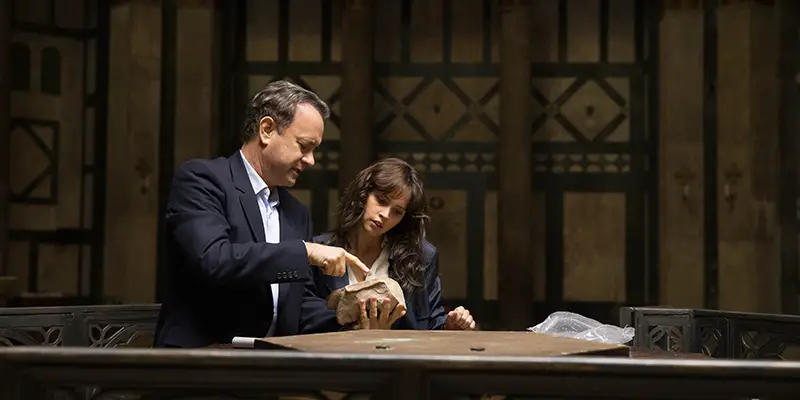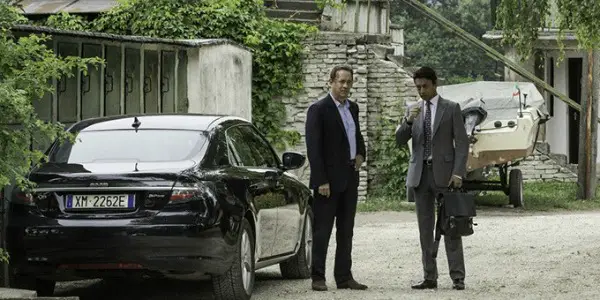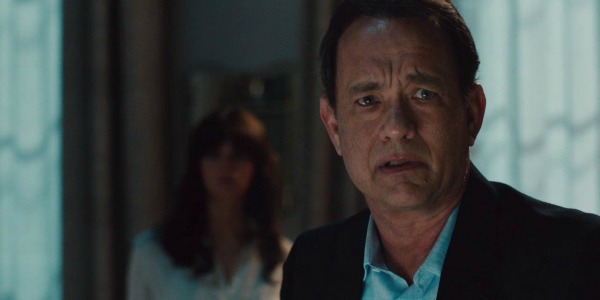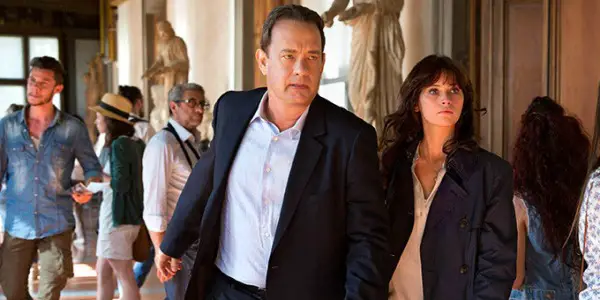INFERNO: Breakneck Thriller Hurtles Right Over Its Plot

Jim Dixon retired from practicing law not a moment too…
Oscar winners Tom Hanks and Ron Howard reunite in their third collaboration on a Dan Brown adaptation, Inferno. Small wonder. The Da Vinci Code grossed better than $750 million worldwide, and its sequel, Angels & Demons, based on a lesser known novel that marked the first appearance of globe-trotting symbologist Robert Langdon, pulled in close to $500 million.
That’s still down quite a bit from the first installment, and that alone might cause some head-scratching as to the wisdom of going back to the well. It’s also been quite a bit of time since Angels & Demons hit the screens, and for some reason, the producers have leapfrogged over the third novel in the Langdon series, The Lost Symbol.
This time around, Langdon awakens in an Italian hospital with a head trauma and no memory of the past 48 hours, which apparently have been pretty busy. An incongruously English ER physician, Sienna Brooks, played by a fetchingly wide-eyed Felicity Jones (The Theory of Everything), in the middle of questioning Langdon, saves the disoriented academic from an assassination attempt, and they, and the audience, are off and running.
Visions of Hell
To make sure no one falls asleep, director Howard peppers the early part of the movie with visions of Hell that would be more at home in End of Days or Constantine than a franchise that prides itself on location shooting. Langdon’s head wound appears to be the culprit, and he attributes the theme of the visions to Botticelli’s illustrations of Danté’s Inferno, although the visions bear more resemblance to Hieronymus Bosch. In any event, a map of hell, at least as conceived of by Botticelli, is the central clue to the puzzle here.

Langdon is always called upon to solve a puzzle, often a literal one. His head injury complicates matters, sort of tying one hand behind his back. But solve a puzzle he must, handicapped or not. The primary puzzle pieces include a lethal virus, a fanatical billionaire geneticist and really big Danté fan (Ben Foster), a mysterious firm that “facilitates” stuff, run by Bollywood superstar Irrfan Khan, in an especially entertaining performance, and, of all things, the World Health Organization, personified by Omar Sy and Sidse Babett Knudsen, both playing enigmatic characters with ulterior motives and hidden agendas. There are lots of references to Danté and Botticelli, which should feel comfortably familiar in a Dan Brown story.
The audience already knows that our crazed billionaire, Bertrand Zobrist (Foster), sort of a Richard Branson/Bill Gates love child, has been preaching about the imminent disasters caused by global overpopulation, and that he’s killed himself in a nod to Vertigo, rather than give up information to Sy. If the description “fanatical billionaire geneticist, and really big Danté fan” in any way troubles you, you probably aren’t a major Dan Brown fan. This type of character pops up in his novels, along with albino assassins, self-castrated fanatics and other assorted mustache-curling, Snidely Whiplash villains.
Time to Save the World – Again
Inferno is also based on a Brown novel, and this time around the schlockbuster scribe is listed as an executive producer. Nonetheless, he’s submitted to a number of plot changes by veteran screenwriter David Koepp (Jurassic Park, Spider-Man, Angels & Demons), most of them for the better if you don’t want your audience throwing things at the screen. In the novel, Zobrist’s biological weapon would cause sterility in much of the human race. the In the movie version, Langdon is hip-deep in a conspiracy to prevent a global pandemic which will “thin the herd” of mankind, preventing humanity’s extinction by annihilating half the human race.

Well, this is very bad, of course, and it certainly seems that someone should stop him. Perversely though, Ben Foster’s YouTube rants are so persuasive the audience is apt to get pretty worried about the overpopulation problem, which having raised, the movie then persistently glosses over. It’s actually a more worrying prospect than the fictional pandemic, which movie audiences are used to. Hasn’t James Bond dealt with this sort of thing multiple times?
Hanks’ Most Charming Take on Robert Langdon Yet
Of course Langdon isn’t supposed to be James Bond. We’re supposed to believe in him. It is in an oddity in modern literary thrillers that writers tend to frame their heroes in such epic scale that Hollywood actually has to tone them down. For example, Stieg Larsson’s Mikael Blomkvist in The Girl With the Dragon Tattoo isn’t just an investigative journalist, but a former army commando who also played in a rock band and beds every female character in the book except his sister.
In the novel The Da Vinci Code, Dan Brown actually described Robert Langdon as looking like “Harrison Ford in Harris tweed,” also alluding to his skill at diving and water polo. One of the smartest things the filmmakers did at the outset was ignore that and cast Tom Hanks instead. Hanks, certainly Hollywood’s most likable major male movie star since Jimmy Stewart, has from the outset imbued Brown’s two-dimensional stiff with an accessible humanity – no mean feat when half his dialogue is spent delivering undergraduate lectures on arcane topics – and this is in many ways his most charming performance in the role to date.
Barreling Over the Plot
The thing here is that, possibly in an effort to keep the tempo up, the expository dialogue is delivered at the same breakneck pace as the rest of the movie. Director Howard has always had sort of a lead foot when it comes to pacing – he did direct the Formula One racing drama Rush after all – and he’s smart enough to know that barreling through certain types of plot material is often a good idea. Yet here he keeps the proceedings moving at such high gear that he literally barrels over the plot. Try this simple trick: can you really explain any exposition that a companion missed while running to the restroom? Smart money is that you can’t.

It’s a little perplexing that there isn’t more suspense or sense of urgency in Inferno. Maybe we’ve seen the world threatened a few too many times. There’s also something of a strictly academic exercise here, even when it comes to uncovering the true motives and loyalties of the supporting characters. It’s more of a game of Clue than it is a true drama, as seriously as the actors, talented all, are taking it. Only Irrfan Khan offers a real breath of fresh air, and he’s by far the best reason to see the movie.
As with The Da Vinci Code and Angels & Demons, the action is played out against picture postcard European locations, shot in dripping honey tones of gold and burnished bronze by Howard veteran director of photography Salvatore Totino (Cinderella Man, The Da Vinci Code, Frost/Nixon, Angels & Demons). This is the first entry in the franchise to be shot digitally.
Conclusion
The thing with Inferno, as with its predecessors, despite the A-list talent both in front of and behind the camera, the result is ultimately something less than the sum of its parts. The Da Vinci Code was instantly notorious because it had the temerity to put the basic premises of Christianity, particularly Catholic Christianity, at the crux of its mystery. That sort of controversy is missing here, and as a result Inferno is, for better or worse, a high-gloss potboiler. Think National Treasure with European locations and without Nicolas Cage.
The film is perfectly watchable, if oddly uninvolving. The scenes between Hanks and Knudsen, alluding to their characters’ backstory, and Khan’s low key ruminations are actually more entertaining, and it sort of makes you wish the filmmakers had slowed down enough to give us a little more of them. What’s the point of saving the world if you can’t enjoy the people in it?
What do you think? Is the world tired of saving-the-world movies, or is Inferno simply just too fast-paced for its own good?
Inferno is now playing in the United States, the United Kingdom, and most of Europe and Asia.
Does content like this matter to you?
Become a Member and support film journalism. Unlock access to all of Film Inquiry`s great articles. Join a community of like-minded readers who are passionate about cinema - get access to our private members Network, give back to independent filmmakers, and more.
Jim Dixon retired from practicing law not a moment too soon, and now works as a freelance writer and film critic. A lifelong and unrepentant movie geek, he firmly believes that everything you need to know in life you can learn at the movies. He lives in upstate New York.













